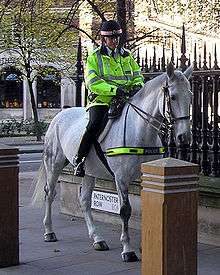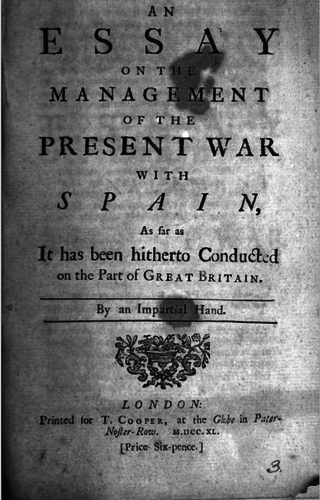Paternoster Row

Paternoster Row was a street in the City of London that is supposed to have received its name from the fact that, when the monks and clergy of St Paul's Cathedral would go in procession chanting the great litany, they would recite the Lord's Prayer (Pater Noster being its opening line in Latin) in the litany along this part of the route. The prayers said at these processions may have also given the names to nearby Ave Maria Lane and Amen Corner. An alternative etymology is the early traders who sold a type of prayer bead known as a "pater noster".
The area was a centre of the London publishing trade,[1][2] with booksellers operating from the street.[3] In 1819 Paternoster Row was described as "almost synonymous" with the book trade.[4]
Trübner & Co. was one of the publishing companies on Paternoster Row. The street was devastated by aerial bombardment during the Blitz of World War II, suffering particularly heavy damage in the night raid of 29–30 December 1940, later characterised as the Second Great Fire of London, during which an estimated 5 million books were lost in the fires caused by tens of thousands of incendiary bombs.[5]
The street was replaced with Paternoster Square, the modern home of the London Stock Exchange, although a City of London Corporation road sign remains in the square near where Paternoster Row once stood.
Printers and booksellers based in Paternoster Row

Note: Before c. 1762 premises in London had signs rather than numbers.
- The Globe - T. Cooper (1740)[6]
- No. 1 - J Van Voorst (1851)[7]
- No. 2 - Orr and Co. (1851),[7] J. W. Myers (~1800)[8]
- No. 3 Jan Van Voorst (1838)[9]
- No. 9 - S. W. Partridge and Co. (1876) [10]
- No. 12 - Trubner and Co (1856)[11]
- No. 15 - Bagster and Sons (1825)[12] (1851)[7]
- No. 20 & 21 - F. Pitman, later F. Pitman Hart and Co. Ltd. (1904) [13]
- No. 21 J. Parsons, (1792)[14]
- No. 23 Piper, Stephenson, and Spence (1857)[15]
- No. 24 - George Wightman (1831)[16]
- No. 31 - Sheed & Ward
- No. 33 - Hamilton and Co. (1851)[7]
- No. 37 - James Duncan (1825-1838) ; Blackwood and Sons, (1851)[7]
- No. 39 - Longman, Hust, Rees, Orme, Brown and Green (1825),[12] later Longman and Co. (1851)[7] later Longmans, Green, and Co. (1902).[17]
- No. 40 – West and Hughes (~1800)[8]
- No. 47 - Chambers (1891), formerly occupied by Baldwin and Craddock[18]
- No. 56 - The Religious Tract Society (1851)[7]
- No. 60 - The Sunday School Union (1851)[7]
- Oxford University Press - Bible warehouse destroyed by fire in 1822,[19] rebuilt c. 1880.
- Sampson Low (after 1887)
- Thomas Nelson[20]
- Hawes, Clarke and Collins (1771) [21]
- H. Woodfall & Co.
- C Davis (1740)[22]
- No, 27 Ivy Lane, Paternoster Row - Walton and Maberly (also at 28 Upper Gower Street) (1837[23]-1857[15])
Others based in Paternoster Row
- No. 60 - Friendly Female Society, "for indigent widows and single women of good character, entirely under the management of ladies."[12]
In popular culture
- The Paternoster Gang are a trio of Victorian detectives aligned with the Doctor in the television series Doctor Who, so named because they are based in Paternoster Row.
- In the episode "Young England" of the 2016 television series Victoria, a stalker of Queen Victoria indicates that he lives on Paternoster Row. (Coincidentally, the actress playing Victoria in the series, Jenna Coleman, had appeared in several episodes of Doctor Who that featured the aforementioned Paternoster Gang.)
See also
References
| Wikimedia Commons has media related to Paternoster Row. |
- ↑ "Districts - Streets - Paternoster Row". Victorian London. Retrieved 2016-11-19.
- ↑ James Raven. The business of books: booksellers and the English Book Trade. 2007
- ↑ "Paternoster Row". Old and New London: Volume 1. 1878. pp. 274–281.
- ↑ A Pictorial and Descriptive Guide to London and Its Environs: With Two Large Section Plans of Central London... Ward, Lock & Company, Limited. 1819.
- ↑ "London Blitz — 29th December 1940 | Iconic Photos". Iconicphotos.wordpress.com. Retrieved 2016-11-19.
- ↑ An Impartial Hand (1740). An Essay on the Management of the Present War with Spain. T. Cooper.
- 1 2 3 4 5 6 7 8 The British Metropolis in 1851
- 1 2 Glasse, Hannah; Maria Wilson (1800). The Complete Confectioner; or, Housekeeper's Guide: To a simple and speedy method of understanding the whole ART OF CONFECTIONARY. London, United Kingdom: West and Hughes.
Printed by J. W. Myers, No. 2, Paternoster-row, London, for West and Hughes, No. 40, Paternoster-row.
- ↑ The Athenaeum: Journal of Literature, Science, the Fine Arts, Music and the Drama. 1838. p. 846.
- ↑ Church of England Temperance Tracts, no. 19, 1876
- ↑ The London catalogue of periodicals, newspapers and transactions of various societies with a list of metropolitan printing societies and clubs. Longman, Brown, Green and Longmans. 1856. p. 3, of wrapper.
- 1 2 3 John Feltham (1825). The picture of London, enlarged and improved (23rd ed.). Longman, Hust, Rees, Orme, Brown and Green. p. iv.
- ↑ The World's Paper Trade Review, May 13, 1904, p. 38
- ↑ Plain truth : or, an impartial account of the proceedings at Paris during the last nine months. Containing, Among other interesting Anecdotes, a particular statement of the memorable tenth of August, and third of September. By an eye witness.. 1792.
- 1 2 The Examiner. John Hunt. 1857. p. 336.
- ↑ William Fox, Robert Raikes (1831). Memoir of W. Fox, Esq., founder of the Sunday-School Society: comprising the history of the origin ... of that ... institution, with correspondence ... between W. Fox, Esq. and R. Raikes, etc. Joseph Ivimey (editor). George Wightman.
- ↑ C. D. Yonge (1902). Gradus Ad Parnassum. London, New York and Bombay: Longmans, Green, and Co. p. title.
- ↑ Henry Benjamin Wheatley (1891). London Past and Present: Its History, Associations, and Traditions. pp. 37–39.
- ↑ Thornbury, Walter (1878). 'Paternoster Row', in Old and New London. Volume 1. London, United Kingdom. pp. 274–281. Retrieved 10 December 2014.
- ↑ "Thomas Bonnar: Overview of Thomas Bonnar". Scottish-places.info. Retrieved 2016-11-19.
- ↑ George Alexander Stevens (1771). The Choice Spirit's Chaplet: Or, a Poesy from Parnassus. Being a Select Collection of Songs, from the Most Approved Authors ; Many of Them Written and the Whole Compiled by George Alexander Stevens, Esq. John Dunn; and sold by Messrs. Hawes, Clarke, and Collins, London. pp. Title page.
- ↑ Zachary Grey (1740). A Vindication of the Government, Doctrine, and Worship, of the Church of England: Established in the Reign of Queen Elizabeth. C. Davis, in Pater-Noster-Row.
- ↑ Augustus De Morgan (1837). Elements of algebra, preliminary to the differential calculus. p. 255.
- 1 2 Herbert Fry (1880), "Paternoster Row", London in 1880, London: David Bogue
Further reading
- John Wallis (1814), "Paternoster Row", London: being a complete guide to the British capital (4th ed.), London: Sherwood, Neely, and Jones, OCLC 35294736
- Henry Benjamin Wheatley (2011) [1891]. "Paternoster Row". London Past and Present: Its History, Associations, and Traditions. Cambridge University Press. ISBN 978-1-108-02808-0.
Coordinates: 51°30′53″N 0°5′53″W / 51.51472°N 0.09806°W